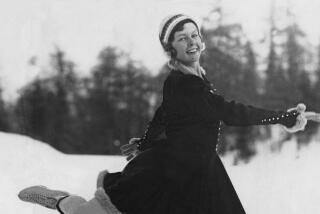Lynn’s Fall at Sapporo Led to Rise in Popularity
- Share via
Falling during Olympic competition usually spells disaster for figure skaters. But Janet Lynn’s tumble, and subsequent reaction to her miscue, during the 1972 Winter Games at Sapporo, Japan, helped elevate the 18-year-old skater to near-legendary status.
Lynn, a five-time U.S. champion on the strength of her free-skating talent, already was out of gold-medal contention in Sapporo because of typically poor marks in what were then-required compulsory figures. During her free skate performance, she fell attempting a flying sit spin. Instead of breaking into tears, Lynn’s face broke out in a smile. She regained her composure and won the bronze medal.
“When I knew I couldn’t win [after the compulsory portion of the competition], I was very distressed and sad,” Lynn told the Chicago Tribune in 1997. “I went back to the Olympic village, and I began crying and arguing with God, saying, ‘I wanted to do it for you, my nation and my coach. I feel like I am such a huge failure.’
“I gathered myself all I could and thought, ‘Perhaps there was a bigger purpose to my skating, to show God’s love and express the gift for skating he gave me.’ Because of that attitude, when I fell, I was able to keep smiling. The next day, I was an instant heroine in Japan.”
Frank Carroll, who has coached many Olympic skaters, once called Lynn, who was not one of his pupils, “the most beautiful, wonderful skater who ever lived....She had such flow to the music, such style.
“She flew, she absolutely flew.”
Lynn, who lives in suburban Detroit, has been married to Richard Salomon since 1975 and has five children. She remains a deeply religious, private person and has kept a low profile since retiring from skating for a second time in 1983.
Born Janet Lynn Nowicki on April 6, 1953, in Chicago, she began skating at age 2 and won her first national championship, the U.S. junior title, in 1966 at 12.
In 1968, she competed in the Winter Games at Grenoble, France, and finished ninth. The next year, she won the first of five consecutive national titles. Before the 1972 Winter Games, she changed her name to the more marketable Janet Lynn.
After her bronze-medal performance at Sapporo, Lynn signed a $1.45-million, three-year contract with the Ice Follies, reportedly making her the highest-paid female athlete in the world.
Lynn, however, was unable to complete the contract. She was plagued by a chronic cough throughout her amateur career, and her health problems worsened as she traveled with the ice show. Lynn once said the show’s manager kept an oxygen tank nearby for when she came off the ice. Her illness eventually was diagnosed as exercise-induced asthma.
She retired in 1975 and, after three years of worsening health, a doctor discovered that Lynn’s condition was caused by an allergy to wheat, yeast, food additives and preservatives. She regained her health after changing her diet and returned to compete in professional skating competitions, retiring again after winning the 1983 World Professional Championship.
Despite never winning a gold medal or world championship, Lynn has had an enduring effect on figure skating. Before the 1973 season, the International Skating Union reduced the value of compulsory figures from 60% to 30% and made two free-skating programs worth 70%. Compulsory figures eventually were eliminated.
More to Read
Go beyond the scoreboard
Get the latest on L.A.'s teams in the daily Sports Report newsletter.
You may occasionally receive promotional content from the Los Angeles Times.







